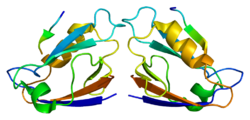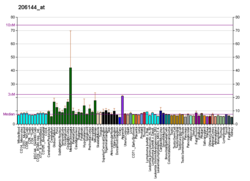MAGI1
Protein-coding gene in the species Homo sapiens From Wikipedia, the free encyclopedia
Membrane-associated guanylate kinase, WW and PDZ domain-containing protein 1 is an enzyme that in humans is encoded by the MAGI1 gene.[5][6][7]
| MAGI1 | |||||||||||||||||||||||||||||||
|---|---|---|---|---|---|---|---|---|---|---|---|---|---|---|---|---|---|---|---|---|---|---|---|---|---|---|---|---|---|---|---|
 | |||||||||||||||||||||||||||||||
| |||||||||||||||||||||||||||||||
| Identifiers | |||||||||||||||||||||||||||||||
| Aliases | MAGI1, AIP-3, AIP3, BAIAP1, BAP-1, BAP1, MAGI-1, Magi1d, TNRC19, WWP3, membrane associated guanylate kinase, WW and PDZ domain containing 1, MAGI-1b | ||||||||||||||||||||||||||||||
| External IDs | OMIM: 602625; MGI: 1203522; HomoloGene: 31257; GeneCards: MAGI1; OMA:MAGI1 - orthologs | ||||||||||||||||||||||||||||||
| |||||||||||||||||||||||||||||||
| |||||||||||||||||||||||||||||||
| |||||||||||||||||||||||||||||||
| |||||||||||||||||||||||||||||||
| Wikidata | |||||||||||||||||||||||||||||||
| |||||||||||||||||||||||||||||||
Function
The protein encoded by this gene is a member of the membrane-associated guanylate kinase homologue (MAGUK) family. MAGUK proteins participate in the assembly of multiprotein complexes on the inner surface of the plasma membrane at regions of cell–cell contact. The product of this gene may play a role as scaffolding protein at cell–cell junctions. Alternatively spliced transcript variants encoding different isoforms have been identified.[7]
Interactions
MAGI1 has been shown to interact with:
References
Further reading
Wikiwand - on
Seamless Wikipedia browsing. On steroids.





